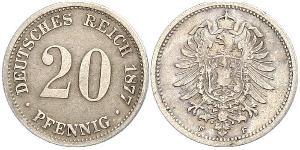(sold for $20.0)
1662, India, Kingdom of Mysore, Kanthirava Narasa Raja. Tiny Gold "Man-Lion" Fanam (1/10 Pagoda) Coin.
Country: India
Condition: Fine!
Mint Period: 1377-1404 AD
State: Kingdom of Mysore (India)
Ruler: Kanthirava Narasa Raja (1638–1659)
Reference: Friedberg 1338, Herrli GF-6.02.01.
Denomination: Gold "Kanthirava (Man-Lion)" Fanam (1/10 Pagoda)
Weight: 0.38gm
Material: Gold!
Diameter: 6mm
Obverse: Narasimha ("Man-lion") diety seated in a Yogabandha position.
Reverse: Legend in three lines.
Legend: "Sri / Kan thi / Ra va"
The "Kanthirava" fanam of Kanthirava Narasa is one of the few Indian coins whose image can be directly related to a known piece of sculpture ... in this case, the famous statue of Narasimha at the Vijayanagar capital of Hampi.
Narasimha (Sanskrit: ??????, Narasi?ha) or Nrusimha (??????, N?si?ha), also spelled as Narasingh, Narsingh and Narasingha, whose name literally translates from Sanskrit as "Man-lion", is an avatar of the Hindu god Vishnu and one of Hinduism's most popular deities, as evidenced in early epics, iconography, and temple and festival worship for over a millennium. Narasimha is often visualized as half-man/half-lion, having a human-like torso and lower body, with a lion-like face and claws. This image is widely worshipped in deity form by a significant number of Vaishnava groups. He is known primarily as the 'Great Protector' who specifically defends and protects his devotees in times of need.
Narasa Raja Wodeyar I (1638–1659) was the Wodeyar ruler of Mysore (a principality or petty kingdom in southern India) from 1638 to 1659.
The previous significant ruler, Chamaraja V, was succeeded by his uncle, who in turn was quickly poisoned on the orders of the Dalavoi (Prime Minister), Vikramaraya, within a year of becoming the wodeyar. The 23-year-old Kanthirava Narasaraja I (also known as Ranadhira Kanteerava Narasa Raja Wodeyar), who had earlier been adopted by the widow of Raja I, became, in 1638, the new Wodeyar of Mysore.Before becoming king of mysore,he lived in terakanambi near gundalpet,chamarajanagar district.
Soon after his accession, he was called on to defend Srirangapatna against the invasions of the Adil Shahis of Bijapur, a defense which he mounted with great loss for the enemy. In the fashion of the two wodeyars before him, he continued to expand the Mysore dominions. This included taking Satyamangalam from the Nayaks of Madurai in the south, unseating the Chingalvas from their base in Piriyapatna in the west, gaining possession of Hosur (near Salem) to the north and delivering a major blow at Yelahanka to the rule of Kempe Gowda of Magadi, from whom a large tribute was exacted. Kanthirava Narasaraja I was also the first wodeyar of Mysore to create the symbols associated with royalty, such as establishing a mint and issuing coins named Kanthiraya (corrupted to "Canteroy") after him. These were to remain a part of Mysore's "current national money" for well over a century. Kanthirava Narasaraja I, who married ten times, died on 31 July 1659, at the age of 44. At his funeral, all his surviving wives committed sati.
Catholic missionaries, who had arrived in the coastal areas of southern India—the Malabar coast, the Kanara coast, and the Coromandel coast—starting early in the sixteenth century, did not begin work in land-locked Mysore until halfway through the seventeenth. The Mysore mission was established in Srirangapatna in 1649 by Leonardo Cinnami, an Italian Jesuit from Goa. Although a few years later Cinnami was expelled from Mysore on account of opposition in Kanthirava's court, the ruler himself was not seen by the Jesuits as unsympathetic, and towards the end of Kanthirava's rule, Cinnami returned to establish missions in half a dozen locations. During his second stay Cinnami obtained permission to convert Kanthirava's subjects to Christianity; however, he was successful mostly in the eastern regions of Kanthirava's dominions, regions that later became part of the Madras Presidency of British India. According to (Subhrahmanyam 1985, p. 209), "Of a reported 1700 converts in the Mysore mission in the mid-1660s, a mere quarter were Kannadigas (Kannada language speakers), the rest being Tamil speakers from the western districts of modern-day Tamilnadu, ..."

|
Posted by:
anonymous 2015-10-07 |
20 Pfennig Germany Silver Wilhelm I, German Emperor (1797-1888)
group has 58 coins / 55 prices
⇑
1 Ducat Kingdom of the Netherlands (1815 - ) Gold
group has 15 coins / 14 prices
⇑

















-300-150-S5IKbzbiDHkAAAFLS6rk0KRZ.jpg)






